Native Shade Plants
There are plenty of native shade plants to chose from. Here are 8 of our favorites.
1. Ferns
Most ferns thrive in shade, and many species are native to North America. A few examples include maidenhair fern, lady fern, cinnamon fern, and ostrich fern. You can find native ferns in various sizes, from ten inches (25 cm) tall to four feet (1.2 m). These are among the most well-adapted shade native plants. The shadiest areas of the garden, where little else will grow, are perfect for ferns. Many ferns prefer moist soil, so don’t grow these in dry areas.
2. Virginia Bluebells (Mertensia virginica)
This pretty woodland flower is a shade-loving perennial that does best in moist areas of the garden. Virginia bluebells are native to the eastern U.S. and Canada and as far west as Kansas. The blue, bell-shaped flowers arrive in early spring to signal the start of the new season. Grow bluebells in zones 3 through 9. This Dennstaedtia punctilobula fern from Green Promise Farms will grow just about anywhere. Sun, shade - it doesn’t care!
3. Hepatica (Hepatica acutiloba and H. americana)
Another attractive woodland flower, hepatica is perfect for shade gardens. Two species are native to North America: round-lobed and sharp-lobed hepatica. The different names describe the shapes of the leaves. Both bloom in spring with blue, pink, lavender, or white flowers. They grow low and in clumps and are hardy in zones 3 through 8.
4. Wild Ginger (Asarum spp.)
You’ll find several species of wild ginger native to most of eastern and central North America. Grow wild ginger for its attractive foliage, which grows low and is suited for growing in clumps or as a groundcover in shade. Most species are hardy in zones 3 through 9. Wild ginger likes rich soil and tolerates moisture and humidity.
5. Dogwood (Cornus spp.)
Several species of dogwood are native to different areas of the U.S. Examples include eastern flowering dogwood and Pacific dogwood. All are shade-tolerant and perfect for a wooded corner of the garden. Most are small, shrubby trees, but creeping dogwood is a low-growing and spreading species. Dogwoods prefer moist soil that drains well and provides spring flowers and fall foliage color.
6. Azalea (Rhododendrun spp.)
Like dogwood, native azaleas thrive in shade-dappled woodland areas. You can find several native species with different flower colors and heights. Florida flame azalea is a Southeast native with bright colors and high heat tolerance. Piedmont azalea is native from North Carolina west to Texas and is one of the taller species. This compact dogwood blooms with white flowers in the spring, but the real show comes in the fall, when its foliage turns to a gorgeous burnished red!
7. Eastern Gamagrass (Tripsacum dactyloides)
Most native ornamental grasses prefer full sun, but you can grow eastern gamagrass in partial shade. It can grow as tall as 12 feet (3.7 m) but typically remains much shorter than that in the garden. It’s a showstopper for areas where you have some shade and room for it to grow and a host for native butterflies. Looking to go beyond azaleas? This kit from Plant by Number includes an azalea bush plus six other pink plants.
8. Virginia Sweetspire (Itea virginica)
Virginia sweetspire is a large deciduous to semi-evergreen shrub with long, arching racemes of white flowers in spring. It also provides fall color with red and purple foliage. It grows best in rich, moist soil in partial shade. Native all over the southeast, Virginia sweetspire is hardy in zones 5 through 9. There are plenty of native plants for shade to choose from, and these are just a few examples. Look for woodland species for the best results. These are plants naturally adapted to partial, dappled, or even deep shade. This article features products available from third-party vendors on the Gardening Know How Shop.
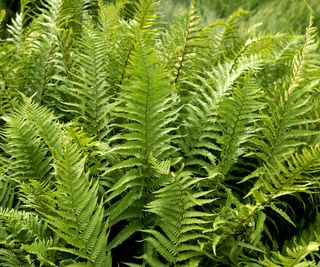
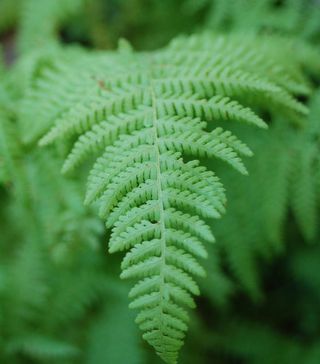
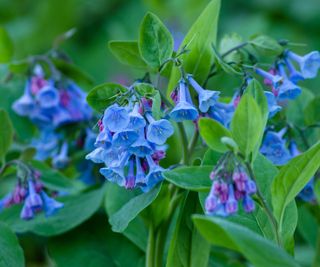
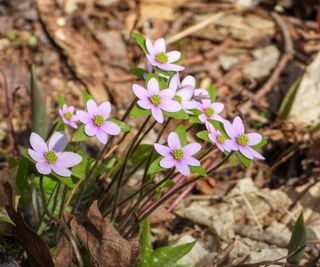
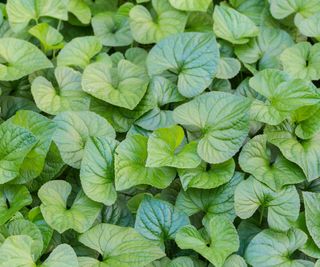
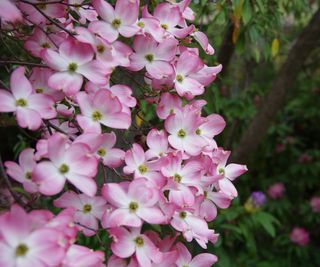
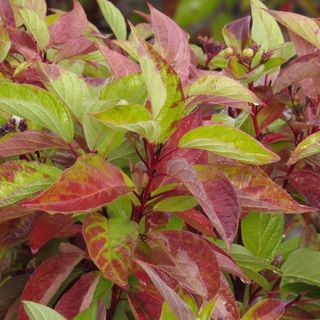
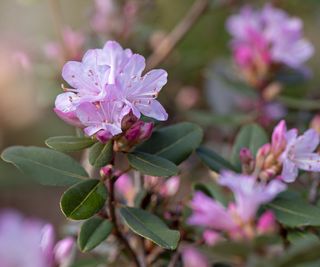
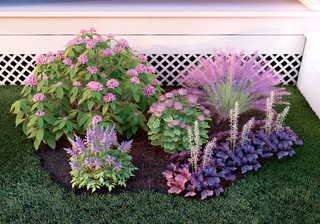
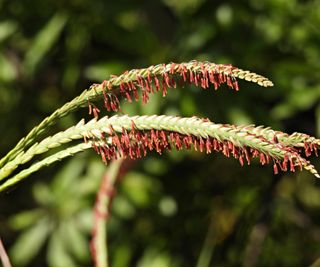
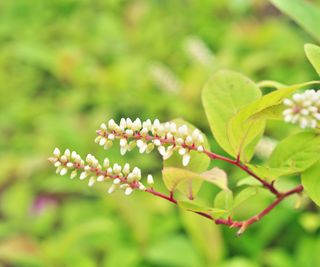
title: “Light Up Your Garden With These 8 Native Shade Loving Plants” ShowToc: true date: “2024-09-17” author: “Frank Horton”
Native Shade Plants
There are plenty of native shade plants to chose from. Here are 8 of our favorites.
1. Ferns
Most ferns thrive in shade, and many species are native to North America. A few examples include maidenhair fern, lady fern, cinnamon fern, and ostrich fern. You can find native ferns in various sizes, from ten inches (25 cm) tall to four feet (1.2 m). These are among the most well-adapted shade native plants. The shadiest areas of the garden, where little else will grow, are perfect for ferns. Many ferns prefer moist soil, so don’t grow these in dry areas.
2. Virginia Bluebells (Mertensia virginica)
This pretty woodland flower is a shade-loving perennial that does best in moist areas of the garden. Virginia bluebells are native to the eastern U.S. and Canada and as far west as Kansas. The blue, bell-shaped flowers arrive in early spring to signal the start of the new season. Grow bluebells in zones 3 through 9. This Dennstaedtia punctilobula fern from Green Promise Farms will grow just about anywhere. Sun, shade - it doesn’t care!
3. Hepatica (Hepatica acutiloba and H. americana)
Another attractive woodland flower, hepatica is perfect for shade gardens. Two species are native to North America: round-lobed and sharp-lobed hepatica. The different names describe the shapes of the leaves. Both bloom in spring with blue, pink, lavender, or white flowers. They grow low and in clumps and are hardy in zones 3 through 8.
4. Wild Ginger (Asarum spp.)
You’ll find several species of wild ginger native to most of eastern and central North America. Grow wild ginger for its attractive foliage, which grows low and is suited for growing in clumps or as a groundcover in shade. Most species are hardy in zones 3 through 9. Wild ginger likes rich soil and tolerates moisture and humidity.
5. Dogwood (Cornus spp.)
Several species of dogwood are native to different areas of the U.S. Examples include eastern flowering dogwood and Pacific dogwood. All are shade-tolerant and perfect for a wooded corner of the garden. Most are small, shrubby trees, but creeping dogwood is a low-growing and spreading species. Dogwoods prefer moist soil that drains well and provides spring flowers and fall foliage color.
6. Azalea (Rhododendrun spp.)
Like dogwood, native azaleas thrive in shade-dappled woodland areas. You can find several native species with different flower colors and heights. Florida flame azalea is a Southeast native with bright colors and high heat tolerance. Piedmont azalea is native from North Carolina west to Texas and is one of the taller species. This compact dogwood blooms with white flowers in the spring, but the real show comes in the fall, when its foliage turns to a gorgeous burnished red!
7. Eastern Gamagrass (Tripsacum dactyloides)
Most native ornamental grasses prefer full sun, but you can grow eastern gamagrass in partial shade. It can grow as tall as 12 feet (3.7 m) but typically remains much shorter than that in the garden. It’s a showstopper for areas where you have some shade and room for it to grow and a host for native butterflies. Looking to go beyond azaleas? This kit from Plant by Number includes an azalea bush plus six other pink plants.
8. Virginia Sweetspire (Itea virginica)
Virginia sweetspire is a large deciduous to semi-evergreen shrub with long, arching racemes of white flowers in spring. It also provides fall color with red and purple foliage. It grows best in rich, moist soil in partial shade. Native all over the southeast, Virginia sweetspire is hardy in zones 5 through 9. There are plenty of native plants for shade to choose from, and these are just a few examples. Look for woodland species for the best results. These are plants naturally adapted to partial, dappled, or even deep shade. This article features products available from third-party vendors on the Gardening Know How Shop.











title: “Light Up Your Garden With These 8 Native Shade Loving Plants” ShowToc: true date: “2024-09-12” author: “John Cantrell”
Native Shade Plants
There are plenty of native shade plants to chose from. Here are 8 of our favorites.
1. Ferns
Most ferns thrive in shade, and many species are native to North America. A few examples include maidenhair fern, lady fern, cinnamon fern, and ostrich fern. You can find native ferns in various sizes, from ten inches (25 cm) tall to four feet (1.2 m). These are among the most well-adapted shade native plants. The shadiest areas of the garden, where little else will grow, are perfect for ferns. Many ferns prefer moist soil, so don’t grow these in dry areas.
2. Virginia Bluebells (Mertensia virginica)
This pretty woodland flower is a shade-loving perennial that does best in moist areas of the garden. Virginia bluebells are native to the eastern U.S. and Canada and as far west as Kansas. The blue, bell-shaped flowers arrive in early spring to signal the start of the new season. Grow bluebells in zones 3 through 9. This Dennstaedtia punctilobula fern from Green Promise Farms will grow just about anywhere. Sun, shade - it doesn’t care!
3. Hepatica (Hepatica acutiloba and H. americana)
Another attractive woodland flower, hepatica is perfect for shade gardens. Two species are native to North America: round-lobed and sharp-lobed hepatica. The different names describe the shapes of the leaves. Both bloom in spring with blue, pink, lavender, or white flowers. They grow low and in clumps and are hardy in zones 3 through 8.
4. Wild Ginger (Asarum spp.)
You’ll find several species of wild ginger native to most of eastern and central North America. Grow wild ginger for its attractive foliage, which grows low and is suited for growing in clumps or as a groundcover in shade. Most species are hardy in zones 3 through 9. Wild ginger likes rich soil and tolerates moisture and humidity.
5. Dogwood (Cornus spp.)
Several species of dogwood are native to different areas of the U.S. Examples include eastern flowering dogwood and Pacific dogwood. All are shade-tolerant and perfect for a wooded corner of the garden. Most are small, shrubby trees, but creeping dogwood is a low-growing and spreading species. Dogwoods prefer moist soil that drains well and provides spring flowers and fall foliage color.
6. Azalea (Rhododendrun spp.)
Like dogwood, native azaleas thrive in shade-dappled woodland areas. You can find several native species with different flower colors and heights. Florida flame azalea is a Southeast native with bright colors and high heat tolerance. Piedmont azalea is native from North Carolina west to Texas and is one of the taller species. This compact dogwood blooms with white flowers in the spring, but the real show comes in the fall, when its foliage turns to a gorgeous burnished red!
7. Eastern Gamagrass (Tripsacum dactyloides)
Most native ornamental grasses prefer full sun, but you can grow eastern gamagrass in partial shade. It can grow as tall as 12 feet (3.7 m) but typically remains much shorter than that in the garden. It’s a showstopper for areas where you have some shade and room for it to grow and a host for native butterflies. Looking to go beyond azaleas? This kit from Plant by Number includes an azalea bush plus six other pink plants.
8. Virginia Sweetspire (Itea virginica)
Virginia sweetspire is a large deciduous to semi-evergreen shrub with long, arching racemes of white flowers in spring. It also provides fall color with red and purple foliage. It grows best in rich, moist soil in partial shade. Native all over the southeast, Virginia sweetspire is hardy in zones 5 through 9. There are plenty of native plants for shade to choose from, and these are just a few examples. Look for woodland species for the best results. These are plants naturally adapted to partial, dappled, or even deep shade. This article features products available from third-party vendors on the Gardening Know How Shop.











title: “Light Up Your Garden With These 8 Native Shade Loving Plants” ShowToc: true date: “2024-10-02” author: “Zachary Rendall”
Native Shade Plants
There are plenty of native shade plants to chose from. Here are 8 of our favorites.
1. Ferns
Most ferns thrive in shade, and many species are native to North America. A few examples include maidenhair fern, lady fern, cinnamon fern, and ostrich fern. You can find native ferns in various sizes, from ten inches (25 cm) tall to four feet (1.2 m). These are among the most well-adapted shade native plants. The shadiest areas of the garden, where little else will grow, are perfect for ferns. Many ferns prefer moist soil, so don’t grow these in dry areas.
2. Virginia Bluebells (Mertensia virginica)
This pretty woodland flower is a shade-loving perennial that does best in moist areas of the garden. Virginia bluebells are native to the eastern U.S. and Canada and as far west as Kansas. The blue, bell-shaped flowers arrive in early spring to signal the start of the new season. Grow bluebells in zones 3 through 9. This Dennstaedtia punctilobula fern from Green Promise Farms will grow just about anywhere. Sun, shade - it doesn’t care!
3. Hepatica (Hepatica acutiloba and H. americana)
Another attractive woodland flower, hepatica is perfect for shade gardens. Two species are native to North America: round-lobed and sharp-lobed hepatica. The different names describe the shapes of the leaves. Both bloom in spring with blue, pink, lavender, or white flowers. They grow low and in clumps and are hardy in zones 3 through 8.
4. Wild Ginger (Asarum spp.)
You’ll find several species of wild ginger native to most of eastern and central North America. Grow wild ginger for its attractive foliage, which grows low and is suited for growing in clumps or as a groundcover in shade. Most species are hardy in zones 3 through 9. Wild ginger likes rich soil and tolerates moisture and humidity.
5. Dogwood (Cornus spp.)
Several species of dogwood are native to different areas of the U.S. Examples include eastern flowering dogwood and Pacific dogwood. All are shade-tolerant and perfect for a wooded corner of the garden. Most are small, shrubby trees, but creeping dogwood is a low-growing and spreading species. Dogwoods prefer moist soil that drains well and provides spring flowers and fall foliage color.
6. Azalea (Rhododendrun spp.)
Like dogwood, native azaleas thrive in shade-dappled woodland areas. You can find several native species with different flower colors and heights. Florida flame azalea is a Southeast native with bright colors and high heat tolerance. Piedmont azalea is native from North Carolina west to Texas and is one of the taller species. This compact dogwood blooms with white flowers in the spring, but the real show comes in the fall, when its foliage turns to a gorgeous burnished red!
7. Eastern Gamagrass (Tripsacum dactyloides)
Most native ornamental grasses prefer full sun, but you can grow eastern gamagrass in partial shade. It can grow as tall as 12 feet (3.7 m) but typically remains much shorter than that in the garden. It’s a showstopper for areas where you have some shade and room for it to grow and a host for native butterflies. Looking to go beyond azaleas? This kit from Plant by Number includes an azalea bush plus six other pink plants.
8. Virginia Sweetspire (Itea virginica)
Virginia sweetspire is a large deciduous to semi-evergreen shrub with long, arching racemes of white flowers in spring. It also provides fall color with red and purple foliage. It grows best in rich, moist soil in partial shade. Native all over the southeast, Virginia sweetspire is hardy in zones 5 through 9. There are plenty of native plants for shade to choose from, and these are just a few examples. Look for woodland species for the best results. These are plants naturally adapted to partial, dappled, or even deep shade. This article features products available from third-party vendors on the Gardening Know How Shop.











title: “Light Up Your Garden With These 8 Native Shade Loving Plants” ShowToc: true date: “2024-10-20” author: “Sam Odonnell”
Native Shade Plants
There are plenty of native shade plants to chose from. Here are 8 of our favorites.
1. Ferns
Most ferns thrive in shade, and many species are native to North America. A few examples include maidenhair fern, lady fern, cinnamon fern, and ostrich fern. You can find native ferns in various sizes, from ten inches (25 cm) tall to four feet (1.2 m). These are among the most well-adapted shade native plants. The shadiest areas of the garden, where little else will grow, are perfect for ferns. Many ferns prefer moist soil, so don’t grow these in dry areas.
2. Virginia Bluebells (Mertensia virginica)
This pretty woodland flower is a shade-loving perennial that does best in moist areas of the garden. Virginia bluebells are native to the eastern U.S. and Canada and as far west as Kansas. The blue, bell-shaped flowers arrive in early spring to signal the start of the new season. Grow bluebells in zones 3 through 9. This Dennstaedtia punctilobula fern from Green Promise Farms will grow just about anywhere. Sun, shade - it doesn’t care!
3. Hepatica (Hepatica acutiloba and H. americana)
Another attractive woodland flower, hepatica is perfect for shade gardens. Two species are native to North America: round-lobed and sharp-lobed hepatica. The different names describe the shapes of the leaves. Both bloom in spring with blue, pink, lavender, or white flowers. They grow low and in clumps and are hardy in zones 3 through 8.
4. Wild Ginger (Asarum spp.)
You’ll find several species of wild ginger native to most of eastern and central North America. Grow wild ginger for its attractive foliage, which grows low and is suited for growing in clumps or as a groundcover in shade. Most species are hardy in zones 3 through 9. Wild ginger likes rich soil and tolerates moisture and humidity.
5. Dogwood (Cornus spp.)
Several species of dogwood are native to different areas of the U.S. Examples include eastern flowering dogwood and Pacific dogwood. All are shade-tolerant and perfect for a wooded corner of the garden. Most are small, shrubby trees, but creeping dogwood is a low-growing and spreading species. Dogwoods prefer moist soil that drains well and provides spring flowers and fall foliage color.
6. Azalea (Rhododendrun spp.)
Like dogwood, native azaleas thrive in shade-dappled woodland areas. You can find several native species with different flower colors and heights. Florida flame azalea is a Southeast native with bright colors and high heat tolerance. Piedmont azalea is native from North Carolina west to Texas and is one of the taller species. This compact dogwood blooms with white flowers in the spring, but the real show comes in the fall, when its foliage turns to a gorgeous burnished red!
7. Eastern Gamagrass (Tripsacum dactyloides)
Most native ornamental grasses prefer full sun, but you can grow eastern gamagrass in partial shade. It can grow as tall as 12 feet (3.7 m) but typically remains much shorter than that in the garden. It’s a showstopper for areas where you have some shade and room for it to grow and a host for native butterflies. Looking to go beyond azaleas? This kit from Plant by Number includes an azalea bush plus six other pink plants.
8. Virginia Sweetspire (Itea virginica)
Virginia sweetspire is a large deciduous to semi-evergreen shrub with long, arching racemes of white flowers in spring. It also provides fall color with red and purple foliage. It grows best in rich, moist soil in partial shade. Native all over the southeast, Virginia sweetspire is hardy in zones 5 through 9. There are plenty of native plants for shade to choose from, and these are just a few examples. Look for woodland species for the best results. These are plants naturally adapted to partial, dappled, or even deep shade. This article features products available from third-party vendors on the Gardening Know How Shop.











title: “Light Up Your Garden With These 8 Native Shade Loving Plants” ShowToc: true date: “2024-09-07” author: “Maria Echols”
Native Shade Plants
There are plenty of native shade plants to chose from. Here are 8 of our favorites.
1. Ferns
Most ferns thrive in shade, and many species are native to North America. A few examples include maidenhair fern, lady fern, cinnamon fern, and ostrich fern. You can find native ferns in various sizes, from ten inches (25 cm) tall to four feet (1.2 m). These are among the most well-adapted shade native plants. The shadiest areas of the garden, where little else will grow, are perfect for ferns. Many ferns prefer moist soil, so don’t grow these in dry areas.
2. Virginia Bluebells (Mertensia virginica)
This pretty woodland flower is a shade-loving perennial that does best in moist areas of the garden. Virginia bluebells are native to the eastern U.S. and Canada and as far west as Kansas. The blue, bell-shaped flowers arrive in early spring to signal the start of the new season. Grow bluebells in zones 3 through 9. This Dennstaedtia punctilobula fern from Green Promise Farms will grow just about anywhere. Sun, shade - it doesn’t care!
3. Hepatica (Hepatica acutiloba and H. americana)
Another attractive woodland flower, hepatica is perfect for shade gardens. Two species are native to North America: round-lobed and sharp-lobed hepatica. The different names describe the shapes of the leaves. Both bloom in spring with blue, pink, lavender, or white flowers. They grow low and in clumps and are hardy in zones 3 through 8.
4. Wild Ginger (Asarum spp.)
You’ll find several species of wild ginger native to most of eastern and central North America. Grow wild ginger for its attractive foliage, which grows low and is suited for growing in clumps or as a groundcover in shade. Most species are hardy in zones 3 through 9. Wild ginger likes rich soil and tolerates moisture and humidity.
5. Dogwood (Cornus spp.)
Several species of dogwood are native to different areas of the U.S. Examples include eastern flowering dogwood and Pacific dogwood. All are shade-tolerant and perfect for a wooded corner of the garden. Most are small, shrubby trees, but creeping dogwood is a low-growing and spreading species. Dogwoods prefer moist soil that drains well and provides spring flowers and fall foliage color.
6. Azalea (Rhododendrun spp.)
Like dogwood, native azaleas thrive in shade-dappled woodland areas. You can find several native species with different flower colors and heights. Florida flame azalea is a Southeast native with bright colors and high heat tolerance. Piedmont azalea is native from North Carolina west to Texas and is one of the taller species. This compact dogwood blooms with white flowers in the spring, but the real show comes in the fall, when its foliage turns to a gorgeous burnished red!
7. Eastern Gamagrass (Tripsacum dactyloides)
Most native ornamental grasses prefer full sun, but you can grow eastern gamagrass in partial shade. It can grow as tall as 12 feet (3.7 m) but typically remains much shorter than that in the garden. It’s a showstopper for areas where you have some shade and room for it to grow and a host for native butterflies. Looking to go beyond azaleas? This kit from Plant by Number includes an azalea bush plus six other pink plants.
8. Virginia Sweetspire (Itea virginica)
Virginia sweetspire is a large deciduous to semi-evergreen shrub with long, arching racemes of white flowers in spring. It also provides fall color with red and purple foliage. It grows best in rich, moist soil in partial shade. Native all over the southeast, Virginia sweetspire is hardy in zones 5 through 9. There are plenty of native plants for shade to choose from, and these are just a few examples. Look for woodland species for the best results. These are plants naturally adapted to partial, dappled, or even deep shade. This article features products available from third-party vendors on the Gardening Know How Shop.











title: “Light Up Your Garden With These 8 Native Shade Loving Plants” ShowToc: true date: “2024-09-25” author: “Traci Wagner”
Native Shade Plants
There are plenty of native shade plants to chose from. Here are 8 of our favorites.
1. Ferns
Most ferns thrive in shade, and many species are native to North America. A few examples include maidenhair fern, lady fern, cinnamon fern, and ostrich fern. You can find native ferns in various sizes, from ten inches (25 cm) tall to four feet (1.2 m). These are among the most well-adapted shade native plants. The shadiest areas of the garden, where little else will grow, are perfect for ferns. Many ferns prefer moist soil, so don’t grow these in dry areas.
2. Virginia Bluebells (Mertensia virginica)
This pretty woodland flower is a shade-loving perennial that does best in moist areas of the garden. Virginia bluebells are native to the eastern U.S. and Canada and as far west as Kansas. The blue, bell-shaped flowers arrive in early spring to signal the start of the new season. Grow bluebells in zones 3 through 9. This Dennstaedtia punctilobula fern from Green Promise Farms will grow just about anywhere. Sun, shade - it doesn’t care!
3. Hepatica (Hepatica acutiloba and H. americana)
Another attractive woodland flower, hepatica is perfect for shade gardens. Two species are native to North America: round-lobed and sharp-lobed hepatica. The different names describe the shapes of the leaves. Both bloom in spring with blue, pink, lavender, or white flowers. They grow low and in clumps and are hardy in zones 3 through 8.
4. Wild Ginger (Asarum spp.)
You’ll find several species of wild ginger native to most of eastern and central North America. Grow wild ginger for its attractive foliage, which grows low and is suited for growing in clumps or as a groundcover in shade. Most species are hardy in zones 3 through 9. Wild ginger likes rich soil and tolerates moisture and humidity.
5. Dogwood (Cornus spp.)
Several species of dogwood are native to different areas of the U.S. Examples include eastern flowering dogwood and Pacific dogwood. All are shade-tolerant and perfect for a wooded corner of the garden. Most are small, shrubby trees, but creeping dogwood is a low-growing and spreading species. Dogwoods prefer moist soil that drains well and provides spring flowers and fall foliage color.
6. Azalea (Rhododendrun spp.)
Like dogwood, native azaleas thrive in shade-dappled woodland areas. You can find several native species with different flower colors and heights. Florida flame azalea is a Southeast native with bright colors and high heat tolerance. Piedmont azalea is native from North Carolina west to Texas and is one of the taller species. This compact dogwood blooms with white flowers in the spring, but the real show comes in the fall, when its foliage turns to a gorgeous burnished red!
7. Eastern Gamagrass (Tripsacum dactyloides)
Most native ornamental grasses prefer full sun, but you can grow eastern gamagrass in partial shade. It can grow as tall as 12 feet (3.7 m) but typically remains much shorter than that in the garden. It’s a showstopper for areas where you have some shade and room for it to grow and a host for native butterflies. Looking to go beyond azaleas? This kit from Plant by Number includes an azalea bush plus six other pink plants.
8. Virginia Sweetspire (Itea virginica)
Virginia sweetspire is a large deciduous to semi-evergreen shrub with long, arching racemes of white flowers in spring. It also provides fall color with red and purple foliage. It grows best in rich, moist soil in partial shade. Native all over the southeast, Virginia sweetspire is hardy in zones 5 through 9. There are plenty of native plants for shade to choose from, and these are just a few examples. Look for woodland species for the best results. These are plants naturally adapted to partial, dappled, or even deep shade. This article features products available from third-party vendors on the Gardening Know How Shop.











title: “Light Up Your Garden With These 8 Native Shade Loving Plants” ShowToc: true date: “2024-08-28” author: “Gene Merkel”
Native Shade Plants
There are plenty of native shade plants to chose from. Here are 8 of our favorites.
1. Ferns
Most ferns thrive in shade, and many species are native to North America. A few examples include maidenhair fern, lady fern, cinnamon fern, and ostrich fern. You can find native ferns in various sizes, from ten inches (25 cm) tall to four feet (1.2 m). These are among the most well-adapted shade native plants. The shadiest areas of the garden, where little else will grow, are perfect for ferns. Many ferns prefer moist soil, so don’t grow these in dry areas.
2. Virginia Bluebells (Mertensia virginica)
This pretty woodland flower is a shade-loving perennial that does best in moist areas of the garden. Virginia bluebells are native to the eastern U.S. and Canada and as far west as Kansas. The blue, bell-shaped flowers arrive in early spring to signal the start of the new season. Grow bluebells in zones 3 through 9. This Dennstaedtia punctilobula fern from Green Promise Farms will grow just about anywhere. Sun, shade - it doesn’t care!
3. Hepatica (Hepatica acutiloba and H. americana)
Another attractive woodland flower, hepatica is perfect for shade gardens. Two species are native to North America: round-lobed and sharp-lobed hepatica. The different names describe the shapes of the leaves. Both bloom in spring with blue, pink, lavender, or white flowers. They grow low and in clumps and are hardy in zones 3 through 8.
4. Wild Ginger (Asarum spp.)
You’ll find several species of wild ginger native to most of eastern and central North America. Grow wild ginger for its attractive foliage, which grows low and is suited for growing in clumps or as a groundcover in shade. Most species are hardy in zones 3 through 9. Wild ginger likes rich soil and tolerates moisture and humidity.
5. Dogwood (Cornus spp.)
Several species of dogwood are native to different areas of the U.S. Examples include eastern flowering dogwood and Pacific dogwood. All are shade-tolerant and perfect for a wooded corner of the garden. Most are small, shrubby trees, but creeping dogwood is a low-growing and spreading species. Dogwoods prefer moist soil that drains well and provides spring flowers and fall foliage color.
6. Azalea (Rhododendrun spp.)
Like dogwood, native azaleas thrive in shade-dappled woodland areas. You can find several native species with different flower colors and heights. Florida flame azalea is a Southeast native with bright colors and high heat tolerance. Piedmont azalea is native from North Carolina west to Texas and is one of the taller species. This compact dogwood blooms with white flowers in the spring, but the real show comes in the fall, when its foliage turns to a gorgeous burnished red!
7. Eastern Gamagrass (Tripsacum dactyloides)
Most native ornamental grasses prefer full sun, but you can grow eastern gamagrass in partial shade. It can grow as tall as 12 feet (3.7 m) but typically remains much shorter than that in the garden. It’s a showstopper for areas where you have some shade and room for it to grow and a host for native butterflies. Looking to go beyond azaleas? This kit from Plant by Number includes an azalea bush plus six other pink plants.
8. Virginia Sweetspire (Itea virginica)
Virginia sweetspire is a large deciduous to semi-evergreen shrub with long, arching racemes of white flowers in spring. It also provides fall color with red and purple foliage. It grows best in rich, moist soil in partial shade. Native all over the southeast, Virginia sweetspire is hardy in zones 5 through 9. There are plenty of native plants for shade to choose from, and these are just a few examples. Look for woodland species for the best results. These are plants naturally adapted to partial, dappled, or even deep shade. This article features products available from third-party vendors on the Gardening Know How Shop.











title: “Light Up Your Garden With These 8 Native Shade Loving Plants” ShowToc: true date: “2024-10-13” author: “Eddie Doster”
Native Shade Plants
There are plenty of native shade plants to chose from. Here are 8 of our favorites.
1. Ferns
Most ferns thrive in shade, and many species are native to North America. A few examples include maidenhair fern, lady fern, cinnamon fern, and ostrich fern. You can find native ferns in various sizes, from ten inches (25 cm) tall to four feet (1.2 m). These are among the most well-adapted shade native plants. The shadiest areas of the garden, where little else will grow, are perfect for ferns. Many ferns prefer moist soil, so don’t grow these in dry areas.
2. Virginia Bluebells (Mertensia virginica)
This pretty woodland flower is a shade-loving perennial that does best in moist areas of the garden. Virginia bluebells are native to the eastern U.S. and Canada and as far west as Kansas. The blue, bell-shaped flowers arrive in early spring to signal the start of the new season. Grow bluebells in zones 3 through 9. This Dennstaedtia punctilobula fern from Green Promise Farms will grow just about anywhere. Sun, shade - it doesn’t care!
3. Hepatica (Hepatica acutiloba and H. americana)
Another attractive woodland flower, hepatica is perfect for shade gardens. Two species are native to North America: round-lobed and sharp-lobed hepatica. The different names describe the shapes of the leaves. Both bloom in spring with blue, pink, lavender, or white flowers. They grow low and in clumps and are hardy in zones 3 through 8.
4. Wild Ginger (Asarum spp.)
You’ll find several species of wild ginger native to most of eastern and central North America. Grow wild ginger for its attractive foliage, which grows low and is suited for growing in clumps or as a groundcover in shade. Most species are hardy in zones 3 through 9. Wild ginger likes rich soil and tolerates moisture and humidity.
5. Dogwood (Cornus spp.)
Several species of dogwood are native to different areas of the U.S. Examples include eastern flowering dogwood and Pacific dogwood. All are shade-tolerant and perfect for a wooded corner of the garden. Most are small, shrubby trees, but creeping dogwood is a low-growing and spreading species. Dogwoods prefer moist soil that drains well and provides spring flowers and fall foliage color.
6. Azalea (Rhododendrun spp.)
Like dogwood, native azaleas thrive in shade-dappled woodland areas. You can find several native species with different flower colors and heights. Florida flame azalea is a Southeast native with bright colors and high heat tolerance. Piedmont azalea is native from North Carolina west to Texas and is one of the taller species. This compact dogwood blooms with white flowers in the spring, but the real show comes in the fall, when its foliage turns to a gorgeous burnished red!
7. Eastern Gamagrass (Tripsacum dactyloides)
Most native ornamental grasses prefer full sun, but you can grow eastern gamagrass in partial shade. It can grow as tall as 12 feet (3.7 m) but typically remains much shorter than that in the garden. It’s a showstopper for areas where you have some shade and room for it to grow and a host for native butterflies. Looking to go beyond azaleas? This kit from Plant by Number includes an azalea bush plus six other pink plants.
8. Virginia Sweetspire (Itea virginica)
Virginia sweetspire is a large deciduous to semi-evergreen shrub with long, arching racemes of white flowers in spring. It also provides fall color with red and purple foliage. It grows best in rich, moist soil in partial shade. Native all over the southeast, Virginia sweetspire is hardy in zones 5 through 9. There are plenty of native plants for shade to choose from, and these are just a few examples. Look for woodland species for the best results. These are plants naturally adapted to partial, dappled, or even deep shade. This article features products available from third-party vendors on the Gardening Know How Shop.










